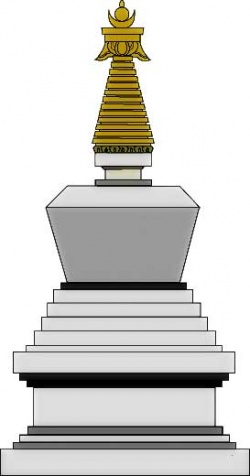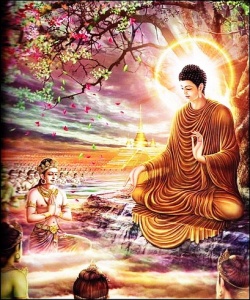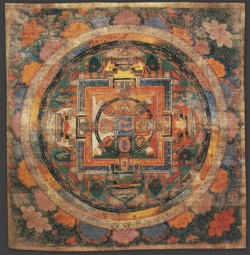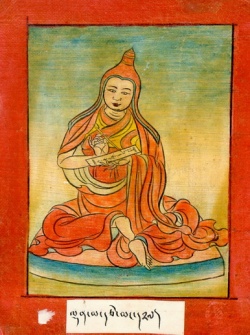Studies on Buddhist Logic and Ontology
Bandyopadhyay, Nandita. 1979. "The Buddhist Theory of Relation between Prama and Pramana." Journal of Indian Philosophy no. 7:43-78.
"The article seeks to introduce Dharmakirti's theory of identity between Prama and Pramana, i.e., valid knowledge and its means. Knowing is nothing but feeling an object-shape stamped upon knowledge. This cognitive object-stamp is the immediate means to knowledge, being the direct measure of its object and as such is not really different from the structure of knowledge itself. The difference is thus only an analytical abstraction having no causal import. Many other systems, even Kumarila Mimansa, on close examination, are reduced to the same position, barring the Nyaya which firmly holds the difference."
Bharadwaja, Vijay K. 1984. "Rationality, Argumentation and Embarrassment: A Study of Four Logical Alternatives (Catuskoti) in Buddhist Logic." Philosophy East and West no. 34 (3):303-319.
Bugault, Guy. 1983. "Logic and Dialectics in the "Madhyamakakarikas"." Journal of Indian Philosophy no. 11:7-76.
Cheng, Hsueh-li. 1984. Empty Logic: Madhyamika Buddhism from Chinese Sources. New York: Philosophical Library.
Reprinted: New Delhi, Motilal Banarsidass, 1991.
Chi, Richard S.Y. 1969. Buddhist Formal Logic. London: Royal Asiatic Society of Great Britain and Ireland.
Part I. A study of Dignaga's Hetucakra and K'uei-chi's Great commentary on the Nyayapraveda.
Reprinted Delhi, Motilal Banarsidass, 1984; contains "A Bibliography of Indian and Buddhist Logic" pp. 181-222.
———. 1974. "Topics on Being and Logical Reasoning." Philosophy East and West no. 24 (3):293-300.
———. 1976. "A Semantic Study of Propositions, East and West." Philosophy East and West no. 26 (2):211-223.
———. 1984. "Buddhist Logic and Western Thought." In Buddhism and American Thinkers, edited by Inada, Kennet K. and Jacobson, Nolan P., 111-119. Albany: State University of New York Press.
Chinchore, Mangala. 1987. "Some Thoughts on Significant Contributions to Buddhist Logicians." Journal of Indian Philosophy no. 15:155-171.
"The paper attempts to show that the difference between "Nyaya" and Buddhism is not merely verbal, but has varied philosophical implications, due to which Nyaya-Buddhist controversy occupies a very important position in the history of indian philosophical thought. This is vindicated with reference to some of the important and significant issues, viz. "sahtana" (the doctrine of universal flux), "anityata/ksanikata" (the doctrine of impermanence), and "vyapti (avinabhava-niyama)", which indicate marked differences between them in the field of metaphysics, epistemology, and logic."
Conze, Edward. 1953. "The Ontology of the Prajnaparamita." Philosophy East and West no. 3 (2):117-129.
———. 1963. "Buddhist Philosophy and Its European Parallels." Philosophy East and West no. 13 (1):9-23.
———. 1963. "Spurious Parallels to Buddhist Philosophy." Philosophy East and West no. 13 (2):105-115.
Daye, Douglas Dunsmore. 1975. "On Logic and Algebraic and Geometric Logic." Philosophy East and West no. 25 (3):357-364.
———. 1975. "Remarks on Early Buddhist Protoformalism (Logic) and Mr. Tachikawa's Translation of the "Nyayapravesa"." Journal of Indian Philosophy no. 3:383-398.
"I discuss some important logical points of translation concerning seven Sanskrit metalogical terms (paksa, hetu, drstanta, rupya, viruddha, viruddhavyabhicari and ubhayatravyabhicara), and some proto-formal theories in light of the probable theoretical formalistic expectations of non-specialists in Buddhist logic, e.g., non-formal criteria in the evaluation rules for determining the legitimacy (not validity) of inference schemas. Additional comments are made on the developmental stages and proto-formalized virtues and limitations of this early Pramana Yada text."
———. 1977. "Metalogical Incompatibilities in the Formal Inscription of Buddhist Logic (Nyaya)." Notre Dame Journal of Formal Logic no. 28 (2):221-231.
———. 1979. "Empirical Falsifiability and the Frequence of Dar'sana Relevance in the Sixth Century Buddhist Logic of Sankaravamin." Logique et Analyse no. 86.
———. 1979. "Metalogical Clichés (Proto-Variables) and Their Restricted Substitution in Sixth Century Buddhist Logic." Notre Dame Journal of Formal Logic no. 20:549-558.
"This paper answers the question: are there variables in early Buddhist logic (Nyaya)? Thus the article describes 1) the implicit rules and sources for the correct substitution of 6th century Buddhist metalogical clichés (proto-variables), 2) some differences between such clichés and modern variables, 3) various metalogical theories and the crucial function of metaphysical presuppositions, and 4) offers a translation into the first order predicate calculus."
———. 1981. "Aspects of the Indian and Western Traditions of Formal Logic and Their Comparisons." In Buddhist and Western Philosophy, edited by Katz, Nathan, 54-79. Atlantic Highlands: Humanities Press.
———. 1988. "On Translating the Term "Drstanta" in Early Buddhist Formal Logic." Philosophy East and West no. 38 (2):147-156.
"The discussion of problems in the translation of "Nyaya/Pramana Vada" terms into their possible English target expressions remains relevant for philosophers because to translate such terms is to presuppose some implicit interpretations of formalistic logic. This takes us beyond the confines of traditional Indology to philosophical questions about comparative formal logics."
Eckel, Malcolm D. 1978. "Bhavaviveka and the Early Madhyamika Theories of Language." Philosophy East and West no. 28 (3):323-337.
"Evidence from Bhavaviveka's Orajnapradipa and Tarkajvala is used to show that Bhavaviveka makes an important contribution to the understanding of Nagarjuna's arguments about the foundations of language. Bhavaviveka's arguments are then compared and contrasted with those of Candrakirti and Tsong-kha-pa."
Ellingson-Waugh, Ter. 1974. "Algebraic and Geometric Logic." Philosophy East and West no. 24 (1):23-40.
Fujinaga, Sin. 1990. "Determining Which Jaina Philosopher Was the Object of Dharmakirti's Criticisms." Philosophy East and West no. 50 (3):378-384.
Galloway, Brian. 1989. "Some Logical Issues in Madhyamaka Thought." Journal of Indian Philosophy no. 17:1-35.
"In this paper we should like to argue that the "Prasajya" negation of the Madhyamaka school of Buddhist philosophy is not the same as that of the non-Madhyamaka schools (that is, that the distinction between "Prasajya" and "Paryudasa" negation is not drawn in the same way). We should also like to argue that the terms and concepts of elementary set theory, employed in conjunction with the elementary predicate calculus, are useful in the explication of the laws of the excluded middle and of contradiction and also in the clarification of the "Catuskoti". Finally we shall defend the Madhyamika Nagarjuna against two charges that have been laid against him to the effect that he has been guilty of certain errors of reasoning."
Gillon, Brendan S. 1997. "Negative Facts and Knowledge of Negative Facts." In Relativism, Suffering and Beyond. Essays in Memory of Bimal K. Matilal, edited by Bilimoria, Purusottama and Mohanty, Jitendra Nath, 128-149. New Delhi: Oxford University Press.
"Negative facts have perplexed Western philosophers ever since the time of Plato.' But the philosophers of Europe and America have not been the only philosophers to have been perplexed by them; classical Indian philosophers too have pondered their nature. My interest here is to explore how the reflections of these classical Indian philosophers, transposed into the contemporary philosophical idiom, might enrich current metaphysical thinking about negative facts; and what I shall conclude is that at least one of these philosophers has a view of negative facts and knowledge of them, which, when so transposed, is very plausible indeed.
I shall begin by asking the fundamental ontological question of whether or not negative facts exist and then sketch various replies which European and American philosophers have given to it. Since these replies have not led to any decisive answer to the question, I shall then ask two other questions: the more specific ontological question of whether or not absences-surely paradigmatic examples of negative facts-exist; and the related epistemological question of what is known when the absence of something is said to be known. Answers to these questions comprise an important part of classical Indian philosophy; and I shall outline their answers to them, concluding that the most plausible answers to these questions are those of Jayanta Bhatta, who maintained that absences do indeed exist and that they are known not only by inference but also by
perception."
Gupta, Rita. 1980. "The Buddhist Doctrine of Momentariness and Its Presuppositions." Journal of Indian Philosophy no. 8:47-68.
"The article first examines the arguments with the help of which philosophers like Dharmakirti established the doctrine of momentariness. The article later proceeds to examine some of the basic presuppositions of the doctrine which are: (I) causal efficacy must be the intrinsic property of a cause, (II) there is no such thing as an unrealized capacity, (III) causal efficacy is the hall mark of the real as opposed to the unreal, and (IV) the identity of a thing is destroyed not only if it happens to be concurrently invested with two contradictory properties, it is destroyed even if the contradictories characterize the thing (at different times)."
———. 1985. "Apoha and the Nominalist/Conceptualist Controversy." Journal of Indian Philosophy no. 13:383-398.
Herzberger, Hans G. 1975. "Double Negation in Buddhist Logic." Journal of Indian Philosophy no. 3:3-16.
"The Apoha doctrine of Dignaga and his followers, presents a fascinating logical puzzle. While rejecting the classical law of double negation, it nevertheless requires a partial semantic equivalence between expression and their double negations. None of the principal nonstandard concepts of negation (classical, intuitionistic, three-valued) can do justice to this complex position. this paper undertakes a semantic reconstruction of the Apoha doctrine, using methods derived from Emil Post's work on the foundations of many-valued logic, especially the notion of a "two-fold" proposition."
Herzberger, Radikha, and Herzberger, Hans G. 1997. "Two Truths, or One?" In Relativism, Suffering and Beyond. Essays in Memory of Bimal K. Matilal, edited by Bilimoria, Purusottama and Mohanty, Jitendra Nath, 278-300. New Delhi: Oxford University Press.
"Thomas Mann begins his essay on Schopenhauer by telling us that the pleasures of metaphysics are mainly aesthetic.
Without sharing that high degree of philosophical detachment, we acknowledge that the present essay was motivated by aesthetic as well as historical concerns. Because it is part of an effort to understand Indian philosophers as particular individuals with distinctive problem situations and doctrines it is properly classified as historical. Because it aims to locate particular doctrines within larger philosophical, visions, it might also be classified as aesthetic. Our essay develop's a long perspective going back to the early origins of pramâna theory. Drawing the reader back in time puts us in a better position to trace historical sources for certain important ideas of Dharmakirti and Dinnaga, and to contrast the treatment of those ideas in their respective philosophical systems."
Huntington, C.W.Jr. 1983. "A "Nonreferential" View of Language and Conceptual Thought in the Work of Tson-Kha-Pa." Philosophy East and West no. 33 (4):325-339.
"Part one of the work briefly describes Wittgenstein's theory of nonreferential meaning, as presented in Gudmunsen's "Wittgenstein and Buddhism". This theory is then applied to the interpretation of an essay by Tson-kha-pa dealing with the "two truths." Part two is an annotated translation of the Tson-kha-pa piece."
Inada, Kennet K. 1988. "The Range of Buddhist Ontology." Philosophy East and West no. 38 (3):261-280.
"The essay aims at the achievement of a proper understanding of Buddhist reality based on the Buddha's original enlightenment. It expands on the three aspects: the locus of reality, its nature and function, and its implication. This reality is a dynamic and open ontology, one that focuses on the momentary nature of ordinary experience. It is a unique ontology which finally affirms the universal nature of the doctrine of emptiness which, in turn, opens up new directions in both ideological and cultural pursuits."
Lance, Factor R. 1983. "What Is the "Logic" in Buddhist Logic?" Philosophy East and West no. 33 (2):183-188.
"In opposition to a contemporary interpretation of the influential Buddhist logic text, "Nyayapravesa" (Introduction to logical methods, circa 600 a. D.) which holds that its argument forms are not deductive and hence not comparable to Western notions of logic, I argue that its basic syllogisms are retroductive-deductive pairs. A Nyaya syllogism is virtually identical with the retroductive form expounded by C.S. Peirce and N. Hanson."
Lindtner, Christian. 1981. "Atisa's Introduction to the Two Truths, and Its Sources." Journal of Indian Philosophy no. 9:161-214.
"This paper presents a survey and an annotated translation (from Tibetan and Sanskrit) of the main Buddhist documents from II-X century a. D. dealing with the 'two truths', or two degrees of reality: a relative and an absolute. The former is the empirical world known to us through the senses and the usage of language. Submitted to sustained critical analysis it proves to be devoid of logical and ontological foundation. Enlightened individuals realizing that there is thus in fact only one truth -- the absolute -- nevertheless avail themselves of the convention of language in order to indicate what cannot be communicated but only 'personally intuited.' Thus the relative truth is pedagogically indispensable."
Liu, Ming-wood. 1993. "A Chinese Madhyamaka Theory of Truth: The Case of Chi-Tsang." Philosophy East and West no. 43 (4):649-673.
"Chi-tsang (549-623) was the key figure in the revival of Chinese Madhyamaka in the late sixth century, and his teaching is commonly acknowledged to be the apex of the development of Madhyamaka thought in China. This essay attempts to examine the conception of truth underlying a number of ideas generally considered as central to Chi-tsang's thought, including "refutation of falsehood", "revelation of truth" and "two truths"."
Loy, David. 1984. "How Not to Criticize Nagarjuna: A Response to L. Stafford Betty." Philosophy East and West no. 34 (4):437-445.
Manchester, Rogers Katherine. 2009. Tibetan Logic. Ithaca: Snow Lions Publications.
Matilal, Bimal Krishna. 1970. "Reference and Existence in Nyaya and Buddhist Logic." Journal of Indian Philosophy no. 1:83-108.
"This Nyaya-Buddhist controversy over the empty subject term may well recall to a modern mind the Meinong-Russell controversy about 'existence' and 'denotation'. The Nyaya and the Buddhist logicians worried over the logical and the epistemological problem connected with the issue. The Nyaya interpreted "the rabbit's horn" not as a singular term but as a predicate complex attributing 'hornness' to something that belonged to the rabbit. "The rabbit's horn does not exist" ascribes the absence of hornness to something belonging to a rabbit, and is true. This analysis is closer to Russell's theory of description. The Buddhist, on the other hand, is prepared to allow some sort of 'fictional existence' to "the rabbit's horn" which is perhaps not very different from Meinong's 'theory of objects'. In epistemology the Nyaya believed that any object of cognition (which is expressible in words) must be either real or analyzable into constituents which are ultimately identifiable with some real entity or other. Only a complex object can be fictional. The Buddhists, however, hold that the objects of erroneous cognition are fictional."
Matilal, Bimal Krishna, and Evans, Robert D., eds. 1986. Buddhist Logic and Epistemology. Studies in the Buddhist Analysis of Inference and Language. Dordrecht: Reidel.
McDermott, Charlene Senape A. 1969. An Eleventh-Century Buddhist Logic of Exists. Dordrecht: Reidel.
———. 1970. "Empty Subject Terms in Late Buddhist Logic." Journal of Indian Philosophy no. 1:22-29.
"One defense of the central tenets of Buddhist metaphysics by the Eleventh century logician, Ratnakirti, culminates in his development of a system broad enough to accommodate null subject terms -- an achievement proleptic of contemporary free logics. The article is intended as an implicit argument in favor of the utilization of formal logical structures as tools for explication in comparative philosophy."
Mortensen, Chris. 2004. "Dharmakirti and Priest on Change." Philosophy East and West no. 54 (1):20-28.
Competing accounts of change and motion are given by the seventh-century Buddhist logician Dharmakirti and the contemporary analytical philosopher Graham Priest. They agree on much, but disagree on the issue of the Law of Non-Contradiction. Priest takes Dharmakirti's side, appealing to current space-time theory, while making some qualifications."
Nakamura, Hajime. 1958. "Buddhist Logic Expounded by Means of Symbolic Logic." Journal of Indian and Buddhist Studies no. 7:375-395.
———. 1987. Indian Buddhism. A Survey with Bibliographical Notes. Delhi: Motilal Banarsidass.
First edition: Japan 1980.
Chapter V. Logicians pp. 294-311.
Ng Yu, Kwan. 1987. "The Arguments of Nagarjuna in the Light of Modern Logic." Journal of Indian Philosophy no. 15:363-384.
Payne, Richard K. 1987. "The Theory of Meaning in Buddhist Logicians: The Historical and Intellectual Context of Apoha." Journal of Indian Philosophy no. 15:261-284.
Perdue, Daniel E. 1992. Debate in Tibetan Buddhism. Ithaca: Snow Lion Publications.
Potter, Karl H., ed. 1999. Encyclopedia of Indian Philosophies. Vol. 8. Buddhist Philosophy from 100 to 350 A.D. Delhi: Motilal Banarsidass.
Potter, Karl H., Buswell, Robert Jr., Jaini, Padmanabh S., and Ross, Reat Noble, eds. 1996. Encyclopedia of Indian Philosophies. Vol. 7. Abhidharma Buddhism to 150 A.D. Delhi: Motilal Banarsidass.
Rajnish, Mishra. 2000. "Buddhist Theory of Meaning." In Signs and Signification. Vol. Ii, edited by Gill, Harjeet Singh and Manetti, Giovanni, 337-358. New Delhi: Bahri Publications.
Robinson, Richard H. 1967. "The Classical Indian Axiomatic." Philosophy East and West no. 17 (1-4):139-154.
Santina, Peter Della. 1987. "The Madhyamaka Philosophy." Journal of Indian Philosophy no. 15:173-185.
"The paper attempts to provide a brief but complete history of the conceptual development of the Madhyamaka system in India from Nagarjuna to Shantarakshita and Kamalashila, including the controversy between the Prasangika and the Svatantrika Schools and the emergence of the synthetic Yogacara-Madhyamaka school. The Madhyamaka system represents the quintessence of the critical attitude in Buddhist philosophy. Nonetheless, in the course of its development, it exhibited logical and idealistic tendencies as well as analytical ones."
Sharma, Dhirendra. 1968. "Buddhist Theory of Meaning (Apoha) and Negative Statements." Philosophy East and West no. 18 (1-2):3-10.
Shaw, Jaysankar Lal. 1974. "Empty Terms: The Nyaya and the Buddhists." Journal of Indian Philosophy no. 2:332-343.
"The purpose of this paper is to explain the Buddhists' conception of empty term, which is linked up with their conception of Sunyata, and to answer some of the questions raised by certain contemporary writers on Nyaya and Buddhism. Moreover, the aim is to show an important function of language which is embedded in the Buddhist philosophy as a whole. A comparison between Russell and the Nyaya has been drawn, and some of the questions raised by Quine have been discussed in this context."
———. 1978. "Negation and the Buddhist Theory of Meaning." Journal of Indian Philosophy no. 6:59-77.
"The aim of this paper is to explain and reconstruct the Buddhist theory of meaning which is formulated in terms of double negation. The Buddhist theory of meaning requires two types of negation for expressing the meaning of an expression. This discussion leads us to an investigation of the different senses of negation used in Indian logic. The first section deals with the different classifications of negation. The second section deals with professor Herzberger's explication of the Buddhist theory of meaning. According to our positive thesis the theory of meaning can be reconstructed in terms of two senses of negation."
Siderits, Mark. 1979. "A Note on the Early Buddhist Theory of Truth." Philosophy East and West no. 29 (4):491-499.
———. 1980. "The Madhyamaka Critique of Epistemology (First Part)." Journal of Indian Philosophy no. 8:307-336.
"A stock objection to the Madhyamaka project of establishing a null ontology is that any knowledge claim requires the existence of objects of knowledge. Here I describe the Nyaya formulation of this objection. Nagarjuna's response, that the theory of knowledge cannot supply us with metaphysical truths, is examined in detail. Finally, I consider the Nyaya defense of epistemology, concluding that it misses the point of Nagarjuna's objection."
———. 1981. "The Madhyamaka Critique of Epistemology (Second Part)." Journal of Indian Philosophy no. 9:121-160.
———. 1985. "Word Meaning, Sentence Meaning and Apoha." Journal of Indian Philosophy no. 13:133-152.
"I show that the Buddhist philosophers Santaraksita and Kamalasila subscribed to the Indian equivalent of the context principle, according to which a word has meaning only in the context of a sentence. I then discuss the manner in which they used the Buddhist exclusion (Apoha) theory of meaning to answer two major objections to that account of word meaning: the "hermeneutic circle" objection, and the objection that this account cannot explain our ability to understand novel sentences."
Stcherbatsky, Fedor Ippolitovich. 1930. Buddhist Logic. Leningrad: Academy of sciences of the U.S.S.R.
Two volumes (1930-1932).
Vol.2 includes "A short treatise of logic (Nyaya-bindu) by Dharmakirti with its commentary (Nyaya-bindu-tika) by Dharmottara translated from the Sanscrit text edited in the Biblioteca Buddhica."
Reprinted: New York, Dover Publications, 1962; Delhi, Motilal Banarsidass Publishers, 1992.
Steinkellner, Ernst, ed. 1991. Studies in the Buddhist Epistemological Tradition. Proceedings of the Second International Dharmakirti Conference, Vienna, June 11-16, 1989. Wien: Verlag der Österreichischen Akademie der Wissenschaften.
Tillemans, Tom J.F. 1984. "Two Tibetan Texts on the "Neither One nor Many" Argument for "Sunyata"." Journal of Indian Philosophy no. 12:357-388.
"This is my third article in a series on a Buddhist Madhyamaka argument for "voidness", that is the impossibility of entities existing themselves. For the previous two articles, see E. Steinkellner and H. Tauscher (eds.) "Contributions on Tibetan and Buddhist religion and philosophy", Vienna 1983, and "Etudes de lettres", 3, University of Lausanne 1982. The present article consists of an annotated translation and a critical edition of sections from two Tibetan texts."
———. 1989. "Formal and Semantic Aspects of Tibetan Buddhist Debate Logic." Journal of Indian Philosophy no. 17:265-297.
———. 1999. Scripture, Logic, Language. Essays on Dharmakirti and His Tibetan Successors. Boston: Wisdom Publications.
Contents: Series Editor's Preface: E. Gene Smith; Acknowledgments and notes on the bibliographic sources; Abbreviations; Introduction; Scripturally based argumentation. 1. Dharmakirti, Aryadeva and Dharmapala on scriptural suthority 27; 2. How much of a proof is scripturally based inference? 37; 3. Pre-Dharmakirti Commentators on the definition of a thesis 53; Logic; 4. On Pararthanumana, Theses and syllogisms 69; 5. On Sapaksa 89; 6. Formal and semantic aspects of Tibetan Buddhist debate logic 117; 7. Dharmakirti and Tibetans on Adrsyanupalabdhihetu 151; 8. What is the Svadharmin in Buddhist logic? 171; 9. Is Buddhist logic non-classical or deviant? 187; Philosophy of language; 10. On the so-called difficult point of the Apoha theory 209; 11. What can one reasonably say about nonexistence? (with Donald S. Lopez, Jr.) 247; Bibliography 285; Index 301.
Tillemans, Tom J.F., and Lopez, Donald S.Jr. 1998. "What Can One Reasonably Say About Nonexistence? A Tibetan Work on the Problem of Asrayasiddha." Journal of Indian Philosophy no. 26:99-129.
Tucci, Giuseppe. 1929. "Buddhist Logic before Dinnaga (Asanga, Vasubandhu, Tarka-Sastras)." Journal of the Royal Asiatic Society of Great Britain and Ireland:451-488.
Waldo, Ives. 1975. "Nagarjuna and Analytic Philosophy." Philosophy East and West no. 25 (3):281-290.
Walser, Joseph. 1998. "On the Formal Arguments of the Akutobhaya." Journal of Indian Philosophy no. 26:189-232.
"Though the Madhyamika school of Buddhism begins with Nagarjuna's Mula Madhyamakakarika, modern scholar's interpretations of this work rely heavily on the commentaries of Buddhapalita, Bhavaviveka and Candrakirti. These commentaries each reflect the so-called "Svatantrika-vs-Prasangika" debate, which became a Madhyamika preoccupation in later times. There are, however, two earlier commentaries which have been largely ignored. This article will demonstrate that one of these commentaries, theAkutobhaya, gives us a rendering of Nagarjuna's logic that is perhaps closer to Nagarjuna's own milieu than post-Dignaga commentaries, such as those of Candrakirti and Bhavaviveka. In this article, I show the ways that the formal argumentation of the Akutobhaya differs from the post-Dignaga logic and seems to conform more closely to an earlier standard set by the early Nyaya and Samkhya schools of logic. The result of this difference in logical methodology is subtle, but nevertheless has ramifications for Madhyamika doctrine."
Watanabe, Fumimaro. 1983. Philosophy and Its Development in the Nikayas and Abhidhamma. Delhi: Motilal Banarsidass.
Wayman, Alex. 1999. A Millennium of Buddhist Logic. Delhi: Motilal Banarsidass.
"This is volume one of texts (from Sanskrit and Tibetan sources) of the two planned volumes on Buddhist Ligic (the second volume to be on topics and opponents). This first volume is in two parts: Part I (Introductory) has Asanga's rules of debate, Dharmakirti's Nyayabindu with Kamalasila's commentary, and Santi-pa's treatise on 'inner pervasion. Part II, devoted to the Dignaga-Dharmakirti system, has five sets of eleven verses, then a study of Bu-Ston's commentary on Dharmakirti's Pramanaviniscaya, and finally Tsong-kha-pa's Mum sel on the seven books of Dharmakirti. The 'Millennium' goes from Asanga to Tsongkha-pa. The texts here included began to be translated in the 1970s, were all in draft renditions in the 1980s, and were brought to their present condition in the 1990s. Doubtless the present volume took longer than originally anticipated, and hopefully this published result will compensate for the many years of delay."
Williams, Paul M. 1980. "Some Aspects of Language and Construction in the Madhyamaka." Journal of Indian Philosophy no. 8:1-45.
"The word 'Prajnapti' in the Madhyamaka designates the status of an entity which has no existence apart from that postulated to fulfill the requirements of linguistic reference. the 'prajnapti' is the referent of a term with no ultimate referent, and is created by language due to the requirement that all terms have referents in order to be meaningful. 'Samjna' involves the classification of a perceptual given in terms of a verbalized subject-predicate formula. The requirement for a referent of the terms involved is fulfilled through the operation of 'Kalpana', and this constructive operation seen as the creation of a semi-permanent entity is referred to under the aspect of 'Parikalpa'. The paper also treats 'Prapanca' and, briefly, 'Drsti'."
———. 1981. "On the Abhidharma Ontology." Journal of Indian Philosophy no. 9:227-257.
"The Sarvastivada ontology maintained that all of which could be an intentional object of consciousness and verbally characterized must exist. Existing solely with self-essence was necessary in order to allow for imagination, memory and the atemporal referring of uniquely individuating descriptions. These entities are primary existents and are constructed into the spatio-temporal everyday world. For a primary existent to be spatio-temporally instantiated is the same thing as for it to be effective, and this sort of existence was radically distinguished from existing simply possessed of self-essence. Secondary existence is constructed out of these as the sort of existence required by non-uniquely individuating intentional acts."
STUDIES ON BUDDHIST LOGICIANS
Bhattacharya, Kamaleswar. 1971. "The Dialectical Method of Nagarjuna." Journal of Indian Philosophy no. 1:217-261.
Bronkhorst, Johannes. 1985. "Nagarjuna and the Naiyayikas." Journal of Indian Philosophy no. 13:107-132.
Chakrabarti, Kisor Kumar. 1987. "The Svabhavahetu in Dharmakirti's Logic." Philosophy East and West no. 37 (4):392-401.
"In the case of a "Svabhavahetu" the generalisation is based on identity. Such general statements are true by virtue of meaning, but they are not contentless. This is in disagreement with a currently popular view that statements true by virtue of meaning must be contentless. The threefold classification of such general statements proposed by Dharmakirti has been explained."
Dreyfus, George B.J. 1997. Recognizing Reality. Dharmakirti's Philosophy and Its Tibetan Interpretations. Albany: State University of New York Press.
Dunne, John D. 2004. Foundations of Dharmakirti's Philosophy. Boston: Wisdom Publications.
Fenner, Peter G. 1983. "Candrakirti's Refutation of Buddhist Idealism." Philosophy East and West no. 33 (3):251-261.
"A philosophical reconstruction of Candrakirti's critique of the Buddhist Vijnanavada as found in the "Madhyamakavatara". The basis of the refutation of idealism is (1) refuting the nonexternality of sense objects, (2) the failure of mental potentials to account for sensory experience and (3) the refutaton of apperception. the relevant verses of the "Madhyamakavatara" are translated in an appendix."
Franco, Eli. 1993. "Did Dignaga Accept Four Types of Perception?" Journal of Indian Philosophy no. 21:295-299.
Ganeri, Jonardon. 1990. "Dharmakirti on Inference and Properties." Journal of Indian Philosophy no. 18:237-247.
Ghose, Ramendra Nath. 1987. "The Modality of Nagarjuna's Dialectics." Journal of Indian Philosophy no. 15:285-309.
"This article provides a clear formulation of the modality of Nagarjuna's method of Prasangapadana (unrestricted reductio ad absurdum) reasoning and demonstrates the systematic uses of its specific form of Prasajya (simple) negation in solving the riddle of four-fold negation. It also gives an interpretation of the reflexive paradox involved in Nagarjuna's self-referential statements on the basis of his intricate texts on logic and middle way dialectics."
Hayes, Richard P. 1987. "On the Reinterpretation of Dharmakirti's "Svabhavahetu"." Journal of Indian Philosophy no. 15:319-332.
———. 1991. "Introduction to Dharmakirti's Theory of Inference as Presented in Ipramanavarttika Svopajnavrttid 1-10." Journal of Indian Philosophy no. 19:1-73.
Herzberger, Radikha. 1986. Bhartrhari and the Buddhists. An Essay in the Development of Fifth and Sixth Century Indian Thought. Dordrecht: Reidel Publishing Company.
Jackson, Roger. 1986. "Dharmakirti's Refutation of Theism." Philosophy East and West no. 36 (4):315-348.
Kalupahana, D.J. 1970. "Dinnaga's Theory of Immaterialism." Philosophy East and West no. 20 (2):121-128.
"The article purports to examine the philosophical speculations of Dinnaga, a Buddhist logician who lived in India during the Fifth century a.D. After a brief historical introduction describing the development of the idealistic school of Buddhism, the teachings of Dinnaga are compared with those of Vasubandhu and the points of difference noted. The arguments adduced by Dinnaga in refutation of the realist theory of perception are then compared with those of the Western philosopher, Berkeley. This has lead to the conclusion that Dinnaga presented a theory of immaterialism comparable to that propounded by Berkeley.
Katsura, Shoryu. 1984. "Dharmakirti's Theory of Truth." Journal of Indian Philosophy no. 12:215-236.
———, ed. 1999. Dharmakirti's Thought and Its Impact on Indian and Tibetan Philosophy. Proceedings of the Third International Dharmakirti Conference, Hiroshima, November 4-6, 1997. Wien: Österreichische Akademie der Wissenschaften.
Krasser, Helmut. 1995. "Dharmottara's Theory of Knowledge in His "Laghu Pramanyapariksa"." Journal of Indian Philosophy no. 23:247-271.
Oetke, Claus. 1991. "Remarks on the Interpretation of Nagarjuna's Philosophy." Journal of Indian Philosophy no. 19:315-323.
Olson, Robert. 1974. "Candrakirti's Critique of Vijnanavada." Philosophy East and West no. 24 (4):405-441.
Paul, Diana. 1979. "An Introductory Note to Paramartha's Theory of Language." Journal of Indian Philosophy no. 7:231-255.
"Paramartha's philosophical views on language focus on the communicative function of language, particularly the arbitrary nature of word-formation, the intentional nature of reference of language, and the influences of language on our attitudes and behavior. All of these features are discussed. A comparison is made between Paramartha's skepticism of the purported truth-expressing dimension of language and Frege's position on the truth-expressing dimension of language. while Frege has skillfully distinguished between sense and reference, Paramartha's main concern is with an issue not addressed by Frege, namely the communication process of language. Paramartha also is shown to have made a logical distinction between sense and reference. The important differences and similarities between these two theories of language are illustrated by the author."
Phillips, Stephen H. 1987. "Dharmakirti on Sensation and Causal Efficiency." Journal of Indian Philosophy no. 15:231-259.
"The Buddhist Dharmakirti (c. 650) is one of the great minds of classical Indian thought, but his main works, apparently lost, were rediscovered only in the Nineteen-Thirties. Much scholarship has been devoted since the rediscovery to the interpretation of his complex positions and subtle arguments. The principal merit of this paper is that it shows how various dimensions of his philosophy -- the logical, epistemological, ontological, and soteriological, fit together as one comprehensive world view. The precise senses in which Dharmakirti's views may be said to be both "pragmatist" and "idealist" are specified, and his arguments for such main tenets as "momentariness" and the "Apoha" logic of concepts are scrutinized, along with his views on sensation and "causal efficiency" as the criterion of the real."
Prasa, Rajendra. 2002. Dharmakirti's Theory of Inference: Revaluation and Reconstruction. New Delhi: Oxford University Press.
Robinson, Richard H. 1956. "Some Logical Aspects of Nagarjuna's System." Philosophy East and West no. 6 (4):291-308.
———. 1972. "Did Nagarjuna Really Refute All Philosophical Views?" Philosophy East and West no. 22 (3):325-331.
Siderits, Mark. 1988. "Nagarjuna as Anti-Realist." Journal of Indian Philosophy no. 18:311-325.
"I dispute B. J. Matilal's representation of the Buddhist philosopher Nagarjuna as a skeptic concerning the possibility of giving an adequate account of the valid means of knowledge. I argue that Nagarjuna is best seen instead as an antirealist who is concerned to undermine the assumptions common to both the realist and the skeptic about knowledge. I reconstruct two arguments of Nagarjuna's, both of which are meant to show that while it is possible to construct a theory of the valid means of knowledge, no such theory can legitimately be used to defend metaphysical realism."
Stafford, Betty L. 1983. "Nagarjuna's Masterpiece -- Logical, Mystical, Both, or Neither?" Philosophy East and West no. 33:123-138.
———. 1984. "Is Nagarjuna a Philosopher: A Response to Professor Loy." Philosophy East and West no. 34 (4):447-450.





















